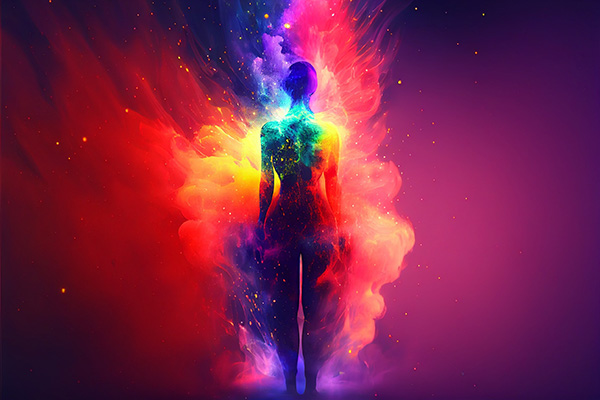The Spiritual Significance Of Colors
 Color permeates our very existence, profoundly affecting our homes, our work environments, the food we eat and the clothes we wear.
Color permeates our very existence, profoundly affecting our homes, our work environments, the food we eat and the clothes we wear.
In every facet of our lives, color exerts a significant influence, shaping our moods, behaviors, and spiritual well-being.
In Kundalini Yoga, for example, teachers traditionally wear white outfits made of natural fibers, along with a white head covering. This custom is not just for practical or aesthetic reasons.
Just as the color white deflects the sun’s rays while black absorbs them, white also deflects negative energy while black attracts and absorbs it.
This practice thus serves a dual purpose: it symbolizes the purity and spiritual clarity that the teacher exemplifies, and it also protects the teacher from negative energy that may emanate from his or her students.
Kundalini Yoga can attract a wide range of students, from those who are highly developed spiritually to those who struggle with emotional instability. The white attire acts as a shield against negative energy that may be projected or “dumped” on the teacher.
In particular, the head covering protects the seventh chakra, which is located at the top of the head. This chakra is essentially our ‘spiritual umbilical cord’ that connects us to God, Source, Spirit, the Divine, so its protection is crucial.
It is also important to note that while the color black can be detrimental in spiritual practices due to its tendency to absorb negative energy, it can be beneficial in physical activities. Wearing black while exercising helps ground the body and provides a sense of stability and focus. This duality highlights the complexity of color symbolism and its varied effects on our physical and spiritual states.
I think the names of colors are at the edge, between where language fails and where it’s at its most powerful ~ A.S. Byatt
Chakra Colors In Everyday Language
Did you know that the energy frequencies of different chakra colors extends even into our everyday language? These metaphysical metaphors not only enrich our language, but also offer insights into the deeper meanings and energetic associations of colors in our lives. Here are some of my favorite examples:
Root Chakra Red: “Seeing red” – This phrase denotes intense fury or anger. The first chakra, or root chakra, is red and represents primal aspects of human nature, including anger and physicality.
Sacral Chakra Orange: “Fired up” – This idiom suggests excitement, enthusiasm, and high energy, which aligns with the second chakra’s association with creativity, passion, and emotional expression.
Solar Plexus Chakra Yellow: “Yellow-bellied” – Associated with cowardice or weakness, yellow is the color of the third chakra, which is associated with strength, determination, willpower and drive.
Heart Chakra Green: “Green-eyed monster” – Symbolizing jealousy and envy, green is associated with the lower fourth chakra, which governs our emotions related to love and balance.
Heart Chakra Pink: “Rose-colored glasses” – Someone having an overly optimistic outlook. Pink, the other color of the higher fourth chakra, represents love, joy and compassion.
Throat Chakra Blue: “Feeling blue” – This idiom is associated with melancholy and unhappiness. Blue is the color of the fifth chakra, located in the throat area, which is associated with self-expression and truthful communication. When we we feel we cannot be ourselves or have to repress our thoughts and feelings, it leads us to “‘feeling blue.'”
Third Eye Chakra Indigo: “Deep as indigo” – This saying signifies profound depth and mystery, aligning with the indigo color’s association with the third eye chakra, which is the center of intuition, wisdom, and inner knowledge. Indigo symbolizes deep understanding and insight.
Crown Chakra Purple: “Born in the Purple” – This saying refers to someone born into a royal or privileged family, indicating a life of luxury and significance. Purple symbolizes the seventh chakra, our energetic ‘crown’ that connects us to the divine and spiritual purity, much like the special status and elevated nature suggested by being “born in the purple.”
Another excellent example is the red, white, and blue of the American flag, representing courage (red), freedom of spiritual expression (white), and freedom of communicative expression (blue). These colors correspond to the first, seventh, and fifth chakras, respectively, highlighting the deep symbolic resonance in cultural symbols around the world.
Similarly, traffic lights use red, yellow, and green to convey important messages: red for stop (root chakra, fear and survival), yellow for caution (third chakra, gut), and green for go (fourth chakra, peace and security). This alignment with the chakras underscores the intuitive way we respond to color cues in our environment.
Fast food restaurants often use red, orange, and yellow in their decor. These colors, associated with the lower chakras, are energizing and stimulate the appetite, encouraging people to eat more and faster. The lower chakras are associated with primal, physical and masculine energies, which are invigorating. In contrast, the colors of the upper chakras – green, blue, purple and white – are calming and soothing, promoting a sense of peace and relaxation.
All the other colors are just colors, but purple seems to have a soul — when you look at it, it’s looking back at you ~ Uniek Swain
Colors In Religion & Spirituality
Colors also hold profound symbolic meanings across various religious and spiritual traditions, enriching ritua ls, and enhancing the spiritual experiences of their adherents. Here are just five examples of color symbolism from diverse religious and spiritual traditions:
Red in Hinduism: In Hinduism, red is a powerful color symbolizing purity, sensuality, and the divine feminine (Shakti). It is often used in religious ceremonies and festivals, such as weddings and Durga Puja. Brides traditionally wear red saris, and red powder (kumkum) is applied to the forehead during various rituals, signifying auspiciousness and energy.
White in Buddhism: In Buddhism, white represents purity, wisdom, and enlightenment. It is often associated with the Buddha and various deities, such as Avalokiteshvara, the Bodhisattva of Compassion, who is depicted in white. Monks in some Buddhist traditions wear white robes during certain ceremonies, and white is used in funeral rites to symbolize the purity of the departed soul.
Green in Islam: Green holds significant importance in Islam, symbolizing paradise, fertility, and life. The Quran mentions the lush, green gardens of paradise, and green is often used in Islamic art and architecture. The dome of the Prophet Muhammad’s mosque in Medina is famously green, and the color is associated with the Prophet himself.
Blue in Judaism: In Judaism, blue represents divinity, the heavens, and spirituality. The tallit (prayer shawl) often has blue stripes, and the tzitzit (fringes) include a blue thread, known as tekhelet, as commanded in the Torah. The color blue is also seen in the Star of David and is used during Hanukkah celebrations to symbolize divine protection and connection to God.
Purple in Christianity: Purple symbolizes penance, humility, and royalty in Christianity. It is prominently used during the liturgical seasons of Advent and Lent. During these periods, clergy wear purple vestments, and purple is used in church decorations to represent a time of preparation and reflection. The color also signifies the royalty of Jesus Christ, acknowledging Him as the King of Kings. The use of purple highlights both the solemnity of repentance and the majesty of Christ’s divine nature.
It’s important to note that color symbolism varies within religions and cultures. For example, while red traditionally symbolizes purity and auspiciousness in Hinduism, it can also have negative connotations in other contexts.
For instance, in Taoist tradition, red is associated with positive attributes such as good fortune and prosperity, but it can also signify excessive or uncontrolled energy. Taoism emphasizes balance and harmony, and the color red, when used excessively or inappropriately, can symbolize overactivity or aggression, which disrupts the natural balance and flow of energy (chi). This nuanced view reflects the broader Taoist principle that every element, including color, holds both positive and negative potential depending on its context and application.
Understanding the profound influence of colors on our lives allows us to harness their power for our benefit. By being mindful of the colors we surround ourselves with, we can create spaces and experiences that support our physical, emotional, and spiritual health.
|
|

Leave a Reply